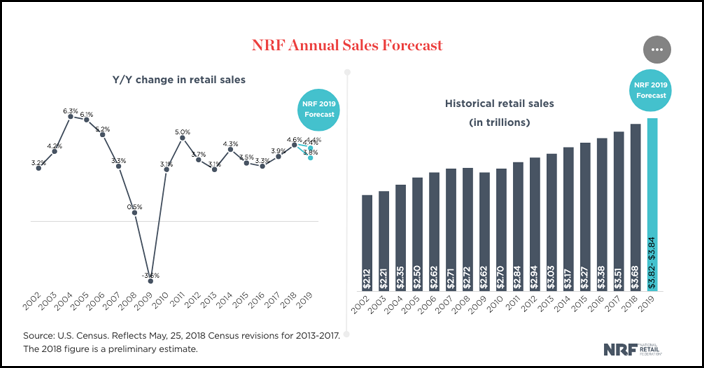Underlying state of the economy described as sound

WASHINGTON — The National Retail Federation (NRF) forecasts U.S. retail sales growth of between 3.8% and 4.4% this year.
If accurate, that means a slight decline from the increase in 2018, when retail sales climbed 4.6%, according to preliminary figures cited by NRF.
“We believe the underlying state of the economy is sound,” commented NRF president and chief executive officer Matthew Shay. “More people are working, they’re making more money, their taxes are lower, and their confidence remains high. The biggest priority is to ensure that our economy continues to grow and to avoid self-inflicted wounds. It’s time for artificial problems like trade wars and shutdowns to end, and to focus on prosperity, not politics.”
Preliminary estimates for 2018 suggest retailers took in $3.68 trillion, a figure that includes online and other non-store sales, which increased 10.4%, but exclude sales at automotive dealers, gasoline stations and restaurants.
The 2018 results are based on Commerce Department data through November and use NRF estimates for December, when the partial government shutdown interrupted the department’s data collection.
“We are not seeing any deterioration in the financial health of the consumer,” commented Jack Kleinhenz, NRF’s chief economist. “Consumers are in better shape than any time in the last few years. Most important for the year ahead will be the ongoing strength in the job market, which will support the consumer income and spending that are both key drivers of the economy. The bottom line is that the economy is in a good place despite the ups and downs of the stock market and other uncertainties. Growth remains solid.”
Kleinhenz foresees inflation and interest rates remaining low in 2019.
Retailers have so far managed to mitigate the impact of new tariffs imposed by the Trump administration on steel, aluminum and other imports from China, NRF commented. But that could change from March 1, when tariffs on $200 billion in Chinese products are scheduled to increase to 25% from 10%.




You must be logged in to post a comment Login